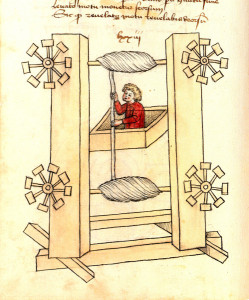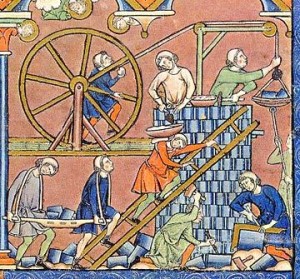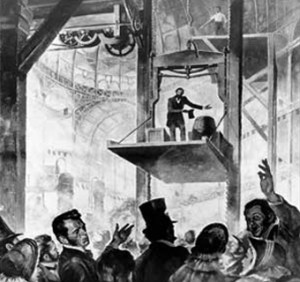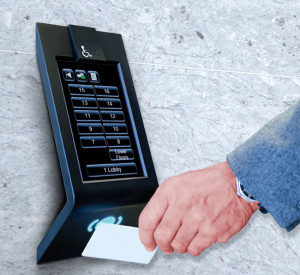After writing a post on the history of the light bulb and GE’s new smart bulb, I pondered the evolution of other everyday inventions. As I was leaving my office yesterday I began to daydream asking myself, “What is an invention that has an impact on my daily life?” Suddenly, a bell dinged and an automated voice announced, “First floor.” I wheeled out of the enclosed platform as the doors opened and thought to myself, “Aha… elevators!” Elevators not only have an impact on my life, they have an impact on just about everyone. What is the history of the elevator? How far has the technology of this invention evolved?
HISTORY
Ancient
Due to their prevalence in our daily lives, many often don’t stop to cogitate on such extraordinary inventions, however, I am very much a child at heart with a grand desire to learn about many modern marvels. I remembered learning of ancient elevators, which were used thousands of years ago by the Egyptians to transport goods such as buckets of water. Studies  show that thousands of slaves worked on those buckets during the farming seasons and would gather the water from the Nile River into clay pots and hoist them to their farms using hemp rope. The Egyptians’ elevator technology was helpful but limited due to its underdevelopment. The more effective elevator technology wasn’t introduced until around 236 B.C. by Greek scientist and inventor Archimedes. His invention was the first to use pulleys and winches, a revolutionary design for elevator technology. For this design, he wound the rope around a wheel and attached two weights on the rope’s ends; if one weight was lighter than the other, then it elevated more easily. The more complex elevator system of ancient times developed around 1st Century B.C. during the Roman Empire, most famously at the Roman Colosseum, where it transported gladiators and wild animals to the arena level. The platform was operated by the power of humans, animals, and water.
show that thousands of slaves worked on those buckets during the farming seasons and would gather the water from the Nile River into clay pots and hoist them to their farms using hemp rope. The Egyptians’ elevator technology was helpful but limited due to its underdevelopment. The more effective elevator technology wasn’t introduced until around 236 B.C. by Greek scientist and inventor Archimedes. His invention was the first to use pulleys and winches, a revolutionary design for elevator technology. For this design, he wound the rope around a wheel and attached two weights on the rope’s ends; if one weight was lighter than the other, then it elevated more easily. The more complex elevator system of ancient times developed around 1st Century B.C. during the Roman Empire, most famously at the Roman Colosseum, where it transported gladiators and wild animals to the arena level. The platform was operated by the power of humans, animals, and water.
Medieval
During the Middle Ages, several monasteries were built on mountains with no surrounding  land access so they used small basket-like elevators (as illustrated on the right) to transport individuals and goods to the high and secluded areas. Little did they know they were opening the door for elevator technology to come.
land access so they used small basket-like elevators (as illustrated on the right) to transport individuals and goods to the high and secluded areas. Little did they know they were opening the door for elevator technology to come.
Age of Enlightenment
The 18th century is often referred to as the “Age of Enlightenment” due to a shift of thinking, shining light on new ideas and inventions, which soon lead humans into the Industrial Revolution. In the late 1700s, Russian inventor Ivan Kulibin demonstrated such enlightenment when he introduced the first elevator operated with a screw mechanism.
Modern
Elevator design completely transformed during the Industrial Revolution after the discovery of hydraulics and electricity. The innovative idea of a moving cabin was thrilling to most, but many had safety concerns. The design used today was first presented in the 1850s with the discovery of a safety device that prevents the cabin from falling. Elisha Graves Otis is the inventor of this device and dramatized his invention on the floor of the Crystal Palace Exposition in New York in front of a large audience. For his demonstration, Otis ascended in an elevator cradled in an exposed shaft, and halfway up he had the main rope cut with an axe causing the platform to drop a few inches then completely stopping. From this moment on, people became more optimistic about being lifted up in multi-storied buildings on the moving platforms. 
PRESENT DAY
For thousands of years, humans have worked on elevation technology; provided the history of elevators, it can be concluded the technology has come a long way. The invention which was once used to raise farmed goods to a higher level–now serves as a cornerstone object for many people, granting them instantaneous access to a higher level. The invention is especially beneficial for individuals with disabilities.
With the extraordinary advancements in the field of technology, elevator companies have aimed to make the machines even more accessible and convenient for all users. Not only are elevators today safer and more efficient, they are also much more flexible in terms of accessibility. This is in part due to recent changes in building and design code requirements. Building owners are becoming more comfortable with new technologies and are embracing the changes.
Due to changes in recent building and ADA code guidelines, elevator companies have had to alter how their existing systems function. Schindler Elevator Company has created what they call PORT technology. This technology not only allows for more efficient elevator  operation, it also allows users with differing abilities to more easily have access to the elevator. PORT technology uses a computer database to control the way the elevator cars travel and which floors they service. This can be especially useful in a high-rise building where multiple cars need to service the same floors. With PORT, a person that needs special access can have a car ready and waiting for them before they even approach it. The cars can even be called in a variety of ways.
operation, it also allows users with differing abilities to more easily have access to the elevator. PORT technology uses a computer database to control the way the elevator cars travel and which floors they service. This can be especially useful in a high-rise building where multiple cars need to service the same floors. With PORT, a person that needs special access can have a car ready and waiting for them before they even approach it. The cars can even be called in a variety of ways.
Recent advances in wireless and data communications have allowed for elevators to be called upon in different and innovative means. A user can call for an elevator to be ready for them as they leave their desk. A user that is unable to reach a operator button can use a wireless remote to allow for easier access. Elevator companies are now developing ways to allow users to utilize their smartphones to call for or operate an elevator. Just imagine approaching your office building and simply telling your phone you want to go to your desk. You enter the building, approach the elevator, and the door magically opens. No more waiting around for an elevator. This is one of the reasons building owners agree with the new technology. They are no longer paying employees to stand in a lobby while the elevator decides what it wants to do.
Even more intriguing is the use of a sip and puff device to call for an elevator. With the assistance of their professor, students at the University of Illinois have developed a system to allow an existing sip and puff control on a power chair to be implemented in controlling an elevator. Over the course of the class, the students designed a device that can be controlled and deployed by the users mouth. They based their design on an actual client that needed such a device. This just helps to show how fast technology is advancing and the potentials there are for people with differing abilities.
Another new advancement in elevator design is with the use of signage and audible announcing of floor and destinations. Users who may be blind or have hearing impairments are now able to utilize elevators to meet their everyday needs. Otis and Schindler elevators now offer different options that designers can choose from when specifying a type of elevator; they even provide systems that can be retro-fitted into existing elevators allowing them to be brought up to newer building code requirements. Many people may have a vision that these systems would be ugly, but in reality they blend in seamlessly with many designs. To the untrained eye, it is hard to tell that these new systems are different in any way.
Many elevator companies have also entered the home elevation sector of business. This has allowed homeowners even more options when it comes to putting an elevator in their home. Not only can these elevators be designed into new construction, they also have the ability to be retrofitted into an existing home. There is no longer a need for bulky and unsightly equipment. These new designs feature sleek and minimalist components that blend seamlessly into a home. One such example is an elevator by Otis that allows for the top and bottom of the cab to act as a floor or ceiling, depending on the current level of operation. A visitor in the home could walk right on top of the elevator cab without even knowing it.
With the rapid pace technology is changing, it is only a question of when, not if, elevator design will advance as well. It is exciting to see how the new technology has improved the lives of so many thus far. The sky is the limit for what can happen for the elevator design field in the future.

Thank you for sharing this information. explained about Elevators are very well informed. We can learn so much through these article . Best Elevator Company in Hyderabad
Reading about the evolution of elevators took me on an emotional journey through time! It’s incredible to think that ancient Egyptians used elevators to transport water, and now we have elevators that provide accessibility and convenience for people with disabilities. The advancements in technology, like the Schindler PORT system and smartphone integration, are truly mind-blowing. I can’t help but feel excited about the future of elevator design and how it will continue to improve and enhance our lives.
It’s mind-boggling to think that ancient Egyptians used elevators to transport water thousands of years ago, while Archimedes revolutionized the design with pulleys and winches. The daring demonstration by Elisha Graves Otis at the Crystal Palace Exposition left me in awe, and now with recent advancements like PORT technology and smartphone integration, elevators have become even more convenient and accessible. The future holds limitless possibilities for elevator design, and I can’t wait to witness the next wave of innovation in this remarkable field!
Reading this post by Laura Medcalf brought back memories of my own experiences with elevators. As a child, I used to marvel at the ancient elevator systems while visiting historical sites, imagining the labor behind their operation. Now, seeing the advancements discussed, especially the integration of technology for accessibility, fills me with hope for a future where everyone can benefit from such innovations. The evolution of elevators truly reflects the progress of humanity, from ancient civilizations to the modern age, and I’m eager to witness where this technology will take us next.
It’s fascinating to realize that the concept of elevators for home dates back thousands of years, with ancient Egyptians using primitive home elevator lift systems to transport water. Archimedes later revolutionized the idea by introducing pulleys and winches—laying the foundation for modern vertical movement. Fast forward to the iconic moment when Elisha Graves Otis wowed the world at the Crystal Palace Exposition, proving the safety and reliability of elevator systems. Today, with cutting-edge advancements like PORT technology and smartphone integration, home hydraulic elevators have become smarter, more accessible, and highly efficient. Whether you’re considering a residential lift elevator, a sleek lift for home, or a robust hydraulic lift, the evolution of home elevators continues to amaze. The future holds boundless possibilities in design and innovation—and I’m excited to see where it takes us!